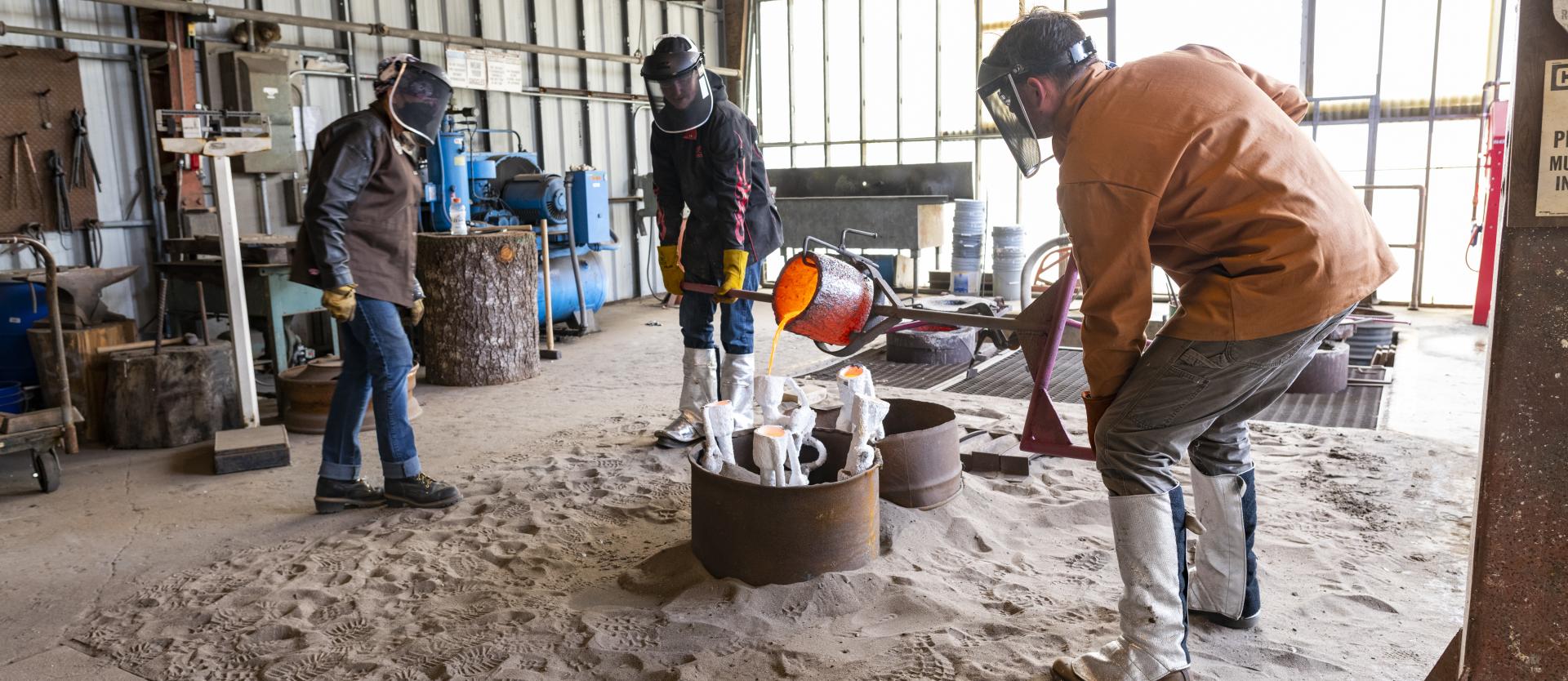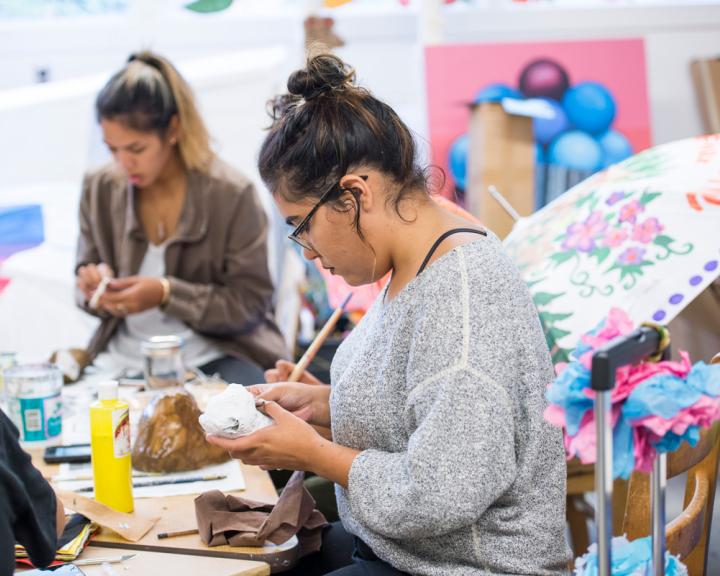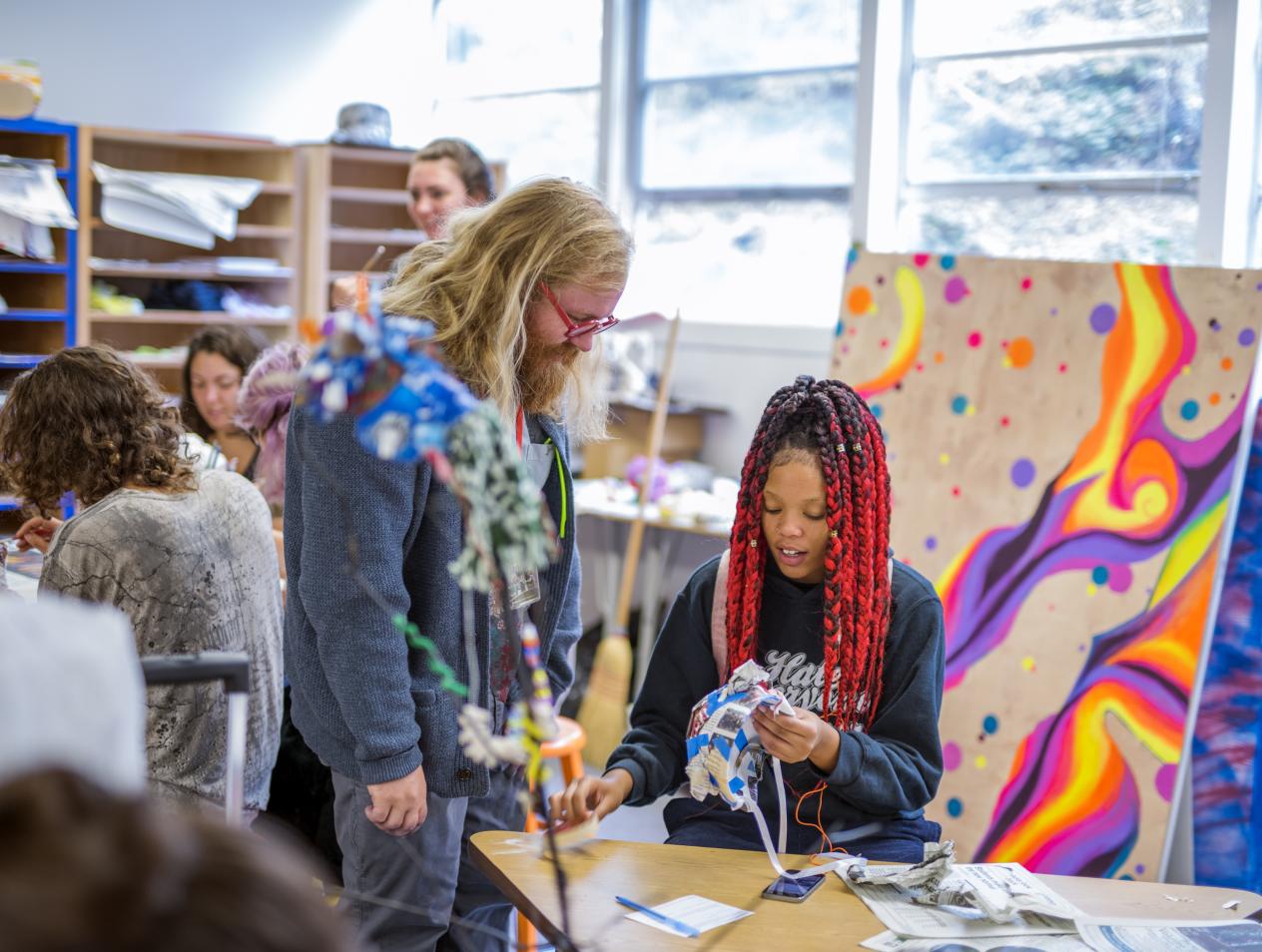Breadcrumb
Art, B.A.
Art is a potent and positive force for change in contemporary society, and Cal Poly Humboldt’s Department of Art + Film is dedicated to educating the students who will shape the culture of our collective future. The hands-on techniques that you’ll learn in our small, intimate classrooms, studios, and galleries will allow you to address issues, ethics, history, and culture with a unique and personal vision in your career.
Art Education
Art Education gives students the tools they need to help others create and appreciate art. Our curriculum provides the foundation to successfully teach art in K-12 schools, higher ed, museums and galleries, and community settings, and prepares students to enter California's mandatory fifth-year, single-subject teaching credential program. Humboldt's Art + Film Department offers an approved subject matter waiver program through the California Commission on Teacher Credentialing.
Art Studio
Art Studio offers small classes with individual attention and large, well-equipped studio facilities. In studio courses, students learn processes and strategies used in creating works of art in various media through problem solving assignments and accompanying instruction. Students are given the opportunity at the upper division level to concentrate on a particular studio area in depth, allowing them to prepare a portfolio for further professional opportunities or for postgraduate study.
Art Studio Areas of Focus
Cal Poly Humboldt's Ceramics program is designed to give students the experience and skills needed to express themselves in every aspect of the medium. Beginning and Intermediate Ceramic courses focus on developing basic forming and glazing skills at both high and low temperatures. Students are exposed to a variety of aesthetic approaches and are helped to develop their creative imagination, visual perception, and understanding of visual form. Advanced level ceramics courses, emphasize the development of a personal style and help prepare students for a career in art. Instruction at this level is largely on an individual basis.
Though Cal Poly Humboldt is a small, intimate school, we are equipped with a comprehensive 8,500-square foot ceramics facility. The studio includes two separate kiln rooms with 14 electric and 4 gas kilns, a large glaze room with spray booth, a plaster mold making area, a clay mixing and storage area, a small room for slide lectures, throwing and hand building areas, an outdoor area kiln area for raku and soda firings, and a separate studio space for our BFA and selected advanced level students.
Ceramics Faculty
The Digital Arts + Graphic Design area utilizes digital media and technology as tools for creative problem solving and artistic expression. Our program emphasizes experimentation, creative thinking, and diverse applications of research with a focus on visual communication.
Our computer lab features up to date Mac computers with industry standard software, printing, scanning and other tools. Students have extended access to the lab, and access an Adobe CC license to work across campus or on a personal device. Together, we develop projects around animation, motion graphics, AR/VR, typography, print, packaging, web and layout design, as well as multimedia approaches. Throughout these projects, students are encouraged to use art and design as pathways that evolve their own learning and ability to express themselves. The Digital Arts + Graphic Design area promotes creative risk takers, collaborative thinkers, and inquisitive innovators that are ready to integrate experimentation and visual communication in their creative practices and professional lives.
Humboldt students educated in an emphasis in digital art have gone on to attain graphic design, film & video, and digital media positions with companies local, regional and beyond. Students may also pursue graduate studies and careers as educators or diverse commercial industries looking for creative thinkers with a rich practice in visual communication.
Graphic Design Faculty
Drawing
Integral to the art curriculum, drawing is one of the most important areas within our department. By developing a strong foundation in drawing, students engage in a process fundamental to many other studio disciplines. Our drawing program offers students an exciting and diverse balance of styles and techniques.
Beginning Drawing courses introduce the basics of line, form, perspective, composition, foreshortening, and proportion, as well as various drawing materials and techniques. Through demonstrations, lectures and critiques, students develop a strong base of technical skill, the ability to assess their own and others' artwork, and the proficiency to think critically and conceptually about drawing. In addition, students are exposed to many styles and characteristics of historical and contemporary drawing.
In our upper level classes, students are encouraged to experiment with new techniques, processes and materials as well as to begin to identify and clarify the content of their art work as it pertains to personal visual expression or style. In addition to courses in Beginning Drawing, we offer Intermediate Drawing as well as Life Drawing I and II.
Painting
The painting program at Humboldt strengthens technical skills and provides in-depth faculty mentoring, yet gives students the freedom to develop a personal style and approach.
The lower division painting courses develop and refine perceptual and technical skills. These foundation courses expose students to the fundamentals of painting: materials, techniques, pictorial organization, form, and color. Once students have developed this technical foundation, the upper division courses provide the opportunity to explore personal vision while delving more deeply into the theories and methods of both traditional and contemporary painting.
In addition to our regular studio courses, we offer workshops on topics such as encaustic, mixed media, landscape, and figure painting. Our studio facilities are open and available from 7:00 am until midnight, seven days a week.
Drawing and Painting Faculty
The Jewelry and Small Metals program provides a strong technical, historical and aesthetic education, blended with creative thinking and artistic problem solving. Students concentrate on the thinking and creating, of wearable jewelry, conceptual work, functional and non- functional objects and small-scale sculpture.
Students can expect visual stimulation through technical demonstrations and samples, contemporary and historical slide shows, videos, and art objects.
The lower division classes stress basic fabrication methods, soldering skills, proper tool usage and safety. The upper division classes build on your foundation skills, offering enameling, raising, anodizing and more. The emphasis at the upper levels is on developing your personal artistic vocabulary and practice.
Although there is an emphasis on non-ferrous metals, exploration is encouraged in a variety of materials including acrylic and resins, tagua nut, leather, handmade papers, exotic woods, found objects and other non-metal materials.
Our studio is well equipped for basic fabrication techniques, chasing, forming and raising, casting, forging, enameling, aluminum anodizing, etching, and basic finishing and polishing processes. Divided into bench and large equipment areas, the studio is a clean and safe environment complete with metal and wood bandsaws, spray etcher, sand and bead blasters, drill presses, bending break, rollers, belt sanders, rolling mills, anvils, and a large assortment of forming hammers and stakes. Every student is assigned a large complement of hand tools for their use during the semester.
Jewelry & Small Metals Faculty
Cal Poly Humboldt offers photography students the opportunity to master all aspects of the photographic process–from traditional darkroom black and white photography to color digital imaging.
Beginning level photography courses provide a strong foundation in camera functions, image editing, darkroom skills and digital processes, while simultaneously encouraging the expressive nature of the medium. At the intermediate and advanced levels, students are encouraged to work toward the development of their own personal style while producing a coherent portfolio. Course work includes use of a view camera, studio lighting, the black & white darkroom, mural printing, alternative processes, and digital photography. Throughout the photography curriculum, group critiques and exposure to historic and contemporary photographs enhance the level of discourse in the program.
Our strength lies in studio access. Our facilities include a chemical lab for black and white printing and a lighting studio. The digital lab is equipped with Mac computers and large format Epson printers for color printing. Our labs are open for extended hours for student use in order to provide abundant time for focused study and practice for the serious photographic artist. Students also have access to a variety of photography equipment, including: digital, 35mm and large format cameras, portable lighting kits, and a professionally equipped lighting studio.
Humboldt students educated in an emphasis in photography have gone on to pursue graduate studies and careers as educators, studio assistants, commercial photographers, and artists.
Photography Faculty
The printmaking program offers beginning through advanced instruction in a variety of processes: relief (woodcut, linocut, wood engraving), intaglio (etching, drypoint), planographic (waterless and stone lithography) and screen print (photo-silkscreen). Students receive a thorough grounding in print fundamentals. Color, black and white, unique, and edition printing are all covered in the curriculum. Traditional and contemporary print techniques are taught through a drawing-centered approach, with an emphasis on individualized conceptual expression.
Our print studio is housed in one large main room, where we have three etching, three lithography and one proof press, work tables and related print equipment. We have an additional small room upstairs which we use as a basic darkroom.
Students graduating with an emphasis in printmaking may elect to pursue graduate studies, work as a printer for fine art or commercial printing houses, or develop independently as an artist.
Printmaking Faculty
Cal Poly Humboldt's sculpture program gives students the tools to transform ideas into tangible three-dimensional form. From small, intimate objects to large, public sculptures, students develop the skills necessary to fabricate, carve, model and cast their own artistic vision.
Our approach to teaching sculpture combines discussions of contemporary sculptural issues with slide lectures, critiques and hands-on studio work. Our introductory coursework lays the foundation for three dimensional thinking and vocabulary. The intermediate-level courses introduce the technical side of working with metals and mixed media. Finally, our advanced courses encourage students to pursue a unique artistic vision with the skills developed throughout the program.
In addition to metal casting and fabrication, the sculpture lab also supports a large mixed media area with equipment for advanced mold making in urethane and silicone rubbers, body casting, water based resins with fiberglass reinforcement, fabrics and fibers, and experimental processes.
In addition to providing extensive studio experience and space, our program also offers several venues for students to exhibit their work, such as the annual Sculpture Walk.
Sculpture Faculty
Why this Program
Our facilities include a foundry, ceramics lab, printmaking studio, photography lab, galleries, and much more. You’ll get hands-on experience in many disciplines of your choosing.
Our small class sizes mean getting to know your professors and fellow students. Your connections will help you grow as an artist and intellectual.
The local area is well-known as an intimate but inclusive arts haven. You’ll interact with professional artists and show art in local galleries.

Did you know?
Art is one of the largest majors at Cal Poly Humboldt.
There are three art galleries on campus, including the Goudi'ni Native American Arts Gallery, which highlights the work of contemporary and traditional Native American artists.
Every second weekend of the month, downtown Arcata puts on Arts! Arcata. It’s a self-guided celebration of visual and performing, and a great opportunity to meet local artists and get to know the community.

Careers
Our alumni have gone on to pursue careers that harness the creative thinking, critical inquiry skills, and communication skills they developed at Humboldt. Art students find a strong foundation in communication skills, informing and explaining ideas, describing and evaluating ideas, problems, and events, and observing people, data, and visual information.
- Animator
- Art Critic
- Art Director
- Curator
- Exhibit Designer
- Fashion Designer
- Graphic Artist
- Illustrator
- Jeweler
- Photographer







